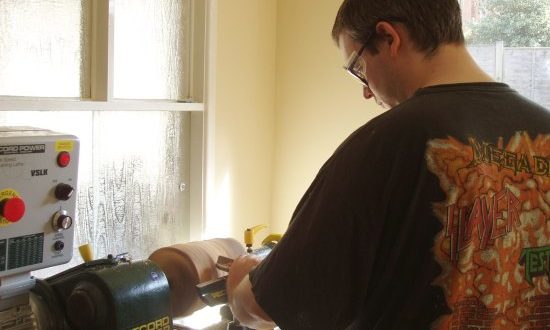Since I now had a chuck and therefore access to the end of the wood I wanted to create a hollow form. I looked at the piece of wood I had mounted in the chuck and felt that perhaps it was a little long (25cm) considering my lack of experience and skill. I thought it was quite tightly clamped though so I would give hollowing a shot – this turned out to be a bad idea.
I currently only own one scraper and it’s a beast at 30mm. The piece of wood I was working was probably only 40mm in diameter and the wood tool combination just looked wrong. I thought I would give it a little shot anyway so I lowered the lathe speed and following all the rules about scraping I gently introduced the tool to the work. Amazingly I didn’t die. The first few seconds went quite well. A little wood came off and a small impression was made in the wood. I moved the tool a little, it caught on something and the wood nearly came out of the chuck.
One emergency stop and reset later I tried again with similar results. My guess is that the far side of the tool is catching on the rising side of the wood causing the tool to dig in. Since the point of support is some 25cm from the point of dig in there is no way for the chuck to keep hold of the work.
Fortunately for me the book I am learning from gives another method of making a small hollow using a spindle gouge. You first use the spindle gouge like an auger to set the depth of the hollow and then hollow out the rest of the piece with a complicated movement from the centre out. Unfortunately for me the book doesn’t describe said manoeuvre very well so using some guess work and what I had already learnt I set about the piece of wood. Amazingly I didn’t die this time either.
Boring the wood auger like went really well with not so much as a wobble. The first tiny bit of wood removal also went pretty well then, you guessed it, I got a dig-in. Not as bad as with the bowl scraper but enough to knock the wood off centre. The problem I found was once the wood had been knocked off centre it was impossible to re-centre it as it had been before which itself tended to cause a dig-in.
I cut off the square bit at the end of the piece of wood and tried again. I was hoping that the shorter bit of wood would be easier to work. Again I got awful dig-ins so I decided to call it a night. The next day I cut the piece in half so I would only be working on roughly 10cm of wood. I thought that would be short enough that I could probably screw up a bit and the chuck would keep hold of it. I was right.
I produced a depth hole and then set about hollowing. I’m not sure my technique is quite right but I was able to hollow fairly quickly and without digging-in. My first hollow piece, a slightly too small egg cup, was made in just under an hour. The next day I made something that more closely resembles a goblet with a half round base.
Since there wasn’t much spare wood between the chuck and the bottom of the piece I decided to part off the pieces with a saw. I first used a skew chisel to define the bottom and give me a good edge and then set the lathe to a low speed and introduced a coping saw. Holding on to the saw tightly I was able to quite easily cut though the piece of wood and leave a fairly clean and flat base. A coping saw is a good choice because the blade is thin enough that it doesn’t stick too much but thick enough that it has some rigidity.
I fine sanded both pieces of work to present them at their best – and to remove some of the many tool marks.
